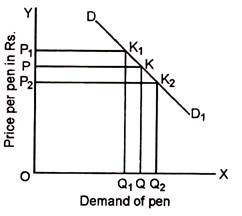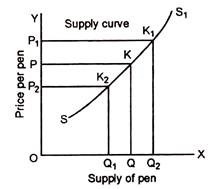The following points highlight the three principles for determining price and value of a commodity.
The principles are: 1. Ancient Theory or Cost of Production Theory of Value 2. Medieval Theory or Marginal Utility Theory of Value 3. Modern Theory or General Theory of Price or Value.
Principle # 1. Ancient Theory or Cost of Production Theory of Value:
This theory was propounded by ancient economists like Ricardo and Mill.
They have pointed out that in the situation of Perfect Competition, the price or value of a commodity is determined by its “Cost of Production”.
ADVERTISEMENTS:
According to this theory a producer will definitely keep the price of his commodity on the basis of cost of production and he will not sell his commodity below the cost of production because in selling the commodity in less than the cost of production, he will suffer loss.
Here the price determination has been considered as “Objective Approach”. Further, the economists have said that this system is “one sided’ as only ‘supply side’ has been taken into consideration and the ‘Demand side’ has been completely ignored.
Therefore, the producer must take into consideration the demand side of the commodity at the time of fixing the price because demand for goods is created by its utility, durability and need of the commodity. Therefore, a purchaser pays for the goods keeping in mind the above written facts. Thus, the modern economists do not consider this system of price fixation of commodity as correct.
Principle # 2. Medieval Theory or Marginal Utility Theory of Value:
The famous pro-pounder of this theory was Jevons. He has written that the price of the commodity is determined not by the ‘cost of production’ but by it ‘utility’ i.e., its marginal utility. This theory is also known as ‘Marginal Utility Theory. In this theory it has been stated that the cost of production of a commodity may be any amount but its price is determined on the utility which the commodity is giving to the consumer.
ADVERTISEMENTS:
If we study this theory it can be said that this theory is also one sided, because in this theory emphasis has been given on demand side only. This has been named as “Subjective approach” to the theory. But from this theory the conclusion can be drawn that both (supply side and demand side) are essential in the price determination under Perfect Competition. One alone is not sufficient to fulfill the requisite of price determination.
Principle # 3. Modern Theory or General Theory of Price or Value:
Prof. Marshall propounded this theory. Both the theories written above (‘cost of production theory’ and ‘cost of utility theory) are one sided. None of the two can be accepted as the correct theory of price determination under Perfect Competition.
Therefore, Marshall has balanced both theories and has said that both are essential and help can be taken from both in price determination and has given his own theory known as “General Theory of Value”.
Marshall is of this opinion that:
ADVERTISEMENTS:
“Price is determined neither by demand nor by supply alone but by the interaction of the two.” Thus Marshall in his theory has put emphasis on both sides {i.e., demand side and supply side) and has written—”Just as we cannot say whether it is the upper or the lower blade of a pair of scissors that cuts a piece of cloth when the two blades operate together, similarly, we cannot say whether demand (depending on utility) alone or supply (depending on cost of production) alone determines value and just as there can be no cutting until the two blades meet. So there can be no value until supply meets demand; the point at which they meet in order to cut, i.e., the equilibrium point is the point at which the value is fixed.”
Thus, neither the upper blade nor the lower one taken individually can do the work of cutting, both have their importance in the process of cutting. The lower blade may be kept stationary and only the upper one may be moved, yet both are indispensable for the process of cutting.
According to Stonier and Hague:
“The only really accurate answer whether it is supply or demand which determines price is that it is both. At time it will seem that one is more important than the other, for one will be active and the other passive. For example: If demand remains constant but supply conditions vary, it is demand which is passive and supply active. But neither of the two is more or less important than the other in determining price.”
The demand of all consumers and the supply of all firms together determine the prices which are then taken as given by each of them. Prices are determined in the market where consumers and sellers meet and exchange takes place among them.
The price which tends to settle down or comes to stay in the market is one at which quantity demanded is equal to quantity supplied. Only at that price will ail buyers and sellers wishes be satisfied.
In this way under Perfect Competition the point at which demand and supply are equal to each other on that point the price is determined and that price is known as Equilibrium Price. The price at which demand and supply are equal is known as an equilibrium price, since at this price the forces of demand and supply are balanced or are in equilibrium.
The quantity bought and sold (or the amount supplied or demanded) at this equilibrium price is known as equilibrium amount.
If the equality between quantity demanded and supplied does not hold for some price, buyers and sellers desires are divergent; either the amount demanded by buyers is more than that offered by sellers, or the amount offered for the supply by sellers is greater than the amount demanded by buyers. In either case, the price will change so as to bring about equality between quantity demanded and quantity supplied.
Law of Demand:
ADVERTISEMENTS:
According to the Law of Demand – Lower the price of the commodity higher will be the demand and higher the price lower will be the demand.
This fact can be explained by the following table:
From the above table it is clear that when the price per pen is Rs. 20. then demand is 10 pen. When price reduces to Rs. 16 then demand increases from 10 to 20. In this way when the price per pen reduces to Rs. 4, then demand increases to 50. In other words, it can be said that when the price of the pen reduces its demand increases and when the price of pen increases, then its demand decreases.
ADVERTISEMENTS:
This statement can be shown in diagramme as follows:
In this diagram on OX axis demand of pen and on OY price pen in Rs. has been shown. From this diagram it is clear that the price per pen (per unit) is P, then the demand for pen is Q. When demand for pen increases from P to P1 then the demand for pen reduces to Q1. Similarly when the Price of pen reduces from P to P2, then the demand for pen increases from Q to Q2 In other-words rise in prices reduces the demand and decrease in prices increases the demand.
Law of Supply:
According to Law of Supply “Lower is the price of the commodity, lower is the supply and higher the price of the commodity higher the supply.” This is quite opposite to the Law of Demand.
ADVERTISEMENTS:
This can be explained by the following table:
From the above it is clear that when the price of pen is Rs. 4 per pen, then its supply is 10. When the price increases from 4 to 8, then supply increases to 20. In this way when price increases to Rs. 20, then its supply increases to 50. It means when price increases supply increase and vice-versa i.e., when price decreases supply decreases. Why such thing happens? Because seller always wants to sell his goods at higher price.
Thus can be explained by diagram as follows:
In this diagram on OX axis supply of pen and on OY axis price per has been shown. Here SS1 line is supply line. It is clear from this diagram that when price is P. Supply of pen is Q. When price P increases to Pi, then supply increases to Q1 and when price reduces to then supply of pen reduces to Q2. From this it is clear that when price increases supply increases and vice-versa.



